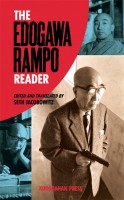 Author: Edogawa Rampo
Author: Edogawa Rampo
Translator: Seth Jacobowitz
U.S. publisher: Kurodahan Press
ISBN: 9784902075250
Released: December 2008
Original release: 1926-1956
The Edogawa Rampo Reader, edited and translated by Seth Jacobowitz, was only the third volume of Edogawa Rampo’s work to be released in English, following Japanese Tales of Mystery and Imagination (which I have read and thoroughly enjoyed) and The Black Lizard and The Beast in the Shadows. Published by Kurodahan Press in 2008, The Edogawa Rampo Reader collects eight of Rampo’s short stories and ten of his essays selected from 1926 through 1956. In addition to these eighteen selections, The Edogawa Rampo Reader also includes a preface by Tatsumi Takayuki and an extensive introduction by Jacobowitz. Prior to the release of The Edogawa Rampo Reader, none of Rampo’s nonfiction work had been translated into English. In fact, all of the selections in The Edogawa Rampo Reader made their first appearance in English in the volume.
After the preface and introduction, The Edogawa Rampo Reader is divided into two sections: The Stories and The Essays. The stories include “The Daydream,” “The Martian Canals,” “The Appearance of Osei,” “Poison Weeds,” “The Stalker in the Attic,” “The Air Raid Shelter,” “Doctor Mera’s Mysterious Crimes,” and “The Dancing Dwarf.” Selected from throughout his career, the works exhibit Rampo’s skills as a mystery writer as well as a writer of the strange. The essays primarily fall into two different categories, those that are at least somewhat autobiographical—”The Horrors of Film,” “Spectral Voices,” “A Passion for Lenses,” “The Phantom Lord,” “My Love for the Printed Word,” and “Confessions of Rampo”—and those that deal with mystery fiction—”Fingerprint Novels of the Meiji Era,” “Dickens vs. Poe,” “An Eccentric Idea,” and “A Desire for Transformation.” Although there are more essays than stories in The Edogawa Rampo Reader, the nonfiction selections tend to be shorter than the fiction and so the section isn’t quite as long.
Whereas Japanese Tales of Mystery and Imagination basically amounted to a “best of” collection of Rampo’s short stories, The Edogawa Rampo Reader was deliberately curated to be representative of the different stages in Rampo’s career. Additionally, the volume emphasizes recurring motifs and themes that Rampo was fond of incorporating into both his fiction and nonfiction. The Edogawa Rampo Reader is meant to be comprehensive, single-volume exploration of Rampo and his work. As much as I enjoy Rampo’s short stories (which I do quite a bit) the real draw of The Edogawa Rampo Reader for me was the essays. Rampo is not only a fascinating author, he is also a fascinating person. His love of reading and writing comes through very clearly in his nonfiction. It was also interesting to see where he found his inspiration as a writer. His own life and imagination were sources, but literature from Japan and the rest of the world were also important influences.
The Edogawa Rampo Reader is a valuable resource. Rampo is an important literary figure in Japan, often cited as the father of modern Japanese mystery and crime fiction. His influence can still be seen today. Rampo is a noteworthy and intriguing creator; it really is a shame that more of his work isn’t available in English. Although they are all very good, I didn’t find the short stories in The Edogawa Rampo Reader to be quite as immediately engaging as those in Japanese Tales of Mystery and Imagination. However, overall the selection is broader in terms of genre and style. My favorite story was probably “The Stalker in the Attic,” which features Rampo’s detective Akechi Kogorō. (I would love to see an entire collection of Akechi stories in English.) But, as already mentioned, Rampo’s essays are really the highlight of the volume. I hope to see more of Rampo’s work released in English, but The Edogawa Rampo Reader makes a fine introduction to the influential author’s life and writing.

[…] …deliberately curated to be representative of the different stages in Ranpo's career. Additionally, the volume emphasizes recurring motifs and themes that Ranpo was fond of incorporating into both his fiction and nonfiction. The Edogawa Rampo Reader is meant to be a comprehensive, single-volume exploration of Ranpo and his work. […] …a valuable resource. —Ash Brown, Experiments in Manga […]